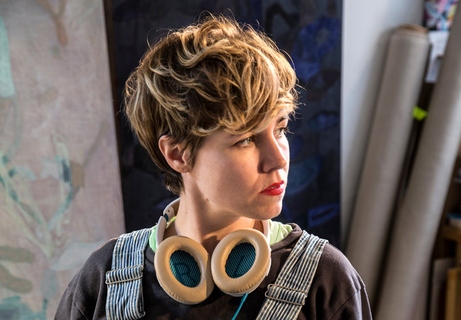Clare Grill in New York Times, April 16, 2015 by William Grimes
Distinct Prisms in an Ever-Shifting Kaleidoscope, by William Grimes
April 17, 2015
With female artists more visible than ever, here are five who have put their stamp on the current gallery moment. They work in studios from Sunnyside to Crown Heights to Paris, in paint, porcelain and pixels.
Clare Grill
When Clare Grill started painting in college, she ran into a problem. Her school, the University of St. Thomas, in St. Paul, Minn., did not have an art department. She signed up for courses at the College of St. Catherine nearby. By her senior year, she was the only student to enroll in advanced painting.
She did receive encouragement. “When I graduated, my art adviser said, ‘You should get your work in coffee shops,’ ” said Ms. Grill, interviewed in her studio in Sunnyside, Queens. “I thought, ‘Yeah, I could do that.’ ”
New York beckoned. On Ms. Grill’s first day in painting class at Pratt Institute in Brooklyn, her teacher told her to check out the galleries in Chelsea. “I had never heard of Chelsea,” she said. “I didn’t know what she was talking about.” She figured it out. Zieher Smith & Horton in Chelsea is now showing nine of her contemplative abstract paintings, medium-scale works with floaty, interwoven patterns, shapes and marks in palettes that range from misty pale greens and lemon yellows to pulsing reds.
Ms. Grill, who grew up in Western Springs, Ill., outside Chicago, worked her way toward abstraction gradually. In retrospect, this evolution looks like a deliberate series of steps. Ms. Grill describes it as a protracted struggle. “I was overthinking everything,” she said, describing one low point. “I felt kind of paralyzed.”
She started out as a figurative painter, working from photographs. Art by Mamma Andersson and Peter Doig helped redefine her relationship to her source material, which she began relying on for mood rather than imagery.
“I was still looking at photographs, but I started to let what was happening on the surface of the painting determine what the final painting would be,” Ms. Grill said. “I let the little decisions become the main thing. The painting still had an available logic, but not anything that you could explain. The story started to fade.” Her current paintings allude to early American sampler embroidery, with hints at leaf forms and letters.
Until recently, Ms. Grill painted on small canvases, but in 2014 she was given a solo show in a large Los Angeles gallery, forcing her to go bigger. The works in her current exhibition are about four feet by five feet. She lays out her canvases on a big table and scoots around them on a rolling chair, working small sections at a time.
She is fond of an expression that a friend once used: You know a painting is a painting when it has a face and looks back at you. She has come up with her own version. “It’s like an important conversation,” she said. “A conversation you don’t forget.





